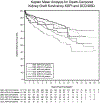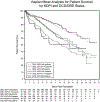The impact of kidney donor profile index on delayed graft function and transplant outcomes: A single-center analysis
- PMID: 29314286
- PMCID: PMC6455919
- DOI: 10.1111/ctr.13190
The impact of kidney donor profile index on delayed graft function and transplant outcomes: A single-center analysis
Abstract
Introduction: Renal transplant outcomes result from a combination of factors. Traditionally, donor factors were summarized by classifying kidneys as extended criteria or standard criteria. In 2014, the nomenclature changed to describe donor factors with the kidney donor profile index (KDPI). We aim to evaluate the relationship between KDPI and delayed graft function (DGF), and the impact KDPI on transplant outcomes for both donor after cardiac death (DCD) and donor after brain death (DBD).
Methods: An IRB-approved single-center retrospective chart review was performed from January 1999 to July 2013. The patients were divided into six groups: DBD KDPI ≤60, DBD KPDI 61-84, DBD KDPI ≥85, DCD KDPI ≤60, DCD KPDI 61-84, and DCD KDPI ≥85. Rates of DGF, patient survival, and graft survival were examined among groups.
Results: A total of 2161 kidney transplants were included. DGF rates increased, and graft and patient survival decreased with increasing KDPI (P < .001). DCD kidneys had higher DGF rates than their DBD counterparts (P < .001). In DCD kidneys, a higher KDPI score did not significantly affect the DGF rates (P > .302). There was no significant difference in graft or patient survival in all-comers when comparing DCD and DBD kidneys with equivalent KDPIs (P > .317). Patients with DGF across all categories demonstrated worse graft half-lives.
Conclusion: The KDPI system is an accurate predictor of donor contributions to transplant outcomes. Recipients of DBD kidneys experience an increase in the rate of DGF as their KDPI increases. DCD kidneys have higher DGF rates than their DBD counterparts with similar KDPIs. Patients with documented post-transplant DGF had between 3- and 5-year shorter graft half-lives when compared to recipients that did not experience DGF. Initiatives to reduce the rate of DGF could provide a significant impact on graft survival and result in a reduction in the number of patients requiring retransplant.
Keywords: DGF,; KDPI; classification systems; delayed graft function; donors and donation: deceased; graft survival; kidney donor profile index; kidney transplant.
© 2018 John Wiley & Sons A/S. Published by John Wiley & Sons Ltd.
Conflict of interest statement
CONFLICT OF INTEREST
The authors declare no conflict of interest.
Figures


References
-
- Israni AK, Zaun D, Rosendale JD, Snyder JJ, Kasiske BL. OPTN/SRTR 2012 Annual Data Report: deceased organ donation. Am J Transplant 2014;14(Suppl 1):167–183. - PubMed
-
- Lee AP, Abramowicz D. Is the kidney donor risk index a step forward in the assessment of deceased donor kidney quality? Nephrol Dial Transplant 2015;30:1285–1290. - PubMed
-
- Rao PS, Schaubel DE, Guidinger MK, et al. A comprehensive risk quantification score for deceased donor kidneys: the kidney donor risk index. Transplantation 2009;88:231–236. - PubMed
-
- Network OPaT. A Guide to Calculating and Interpreting the Kidney Donor Profile Index (KDPI) Available at: https://optn.transplant.hrsa.gov/media/1512/guide_to_calculating_interpr...: Network OPaT; 2014.
Publication types
MeSH terms
Grants and funding
LinkOut - more resources
Full Text Sources
Other Literature Sources
Medical

